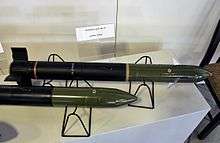9M117 Bastion
The 9M117 Bastion is a Russian laser beam-riding anti-tank missile. It is used in a number of separate weapon systems, including the 9K116-1 Bastion missile system (AT-10 Stabber), 9K118 Sheksna (AT-12 Swinger), T-12 antitank gun and the 3UBK12 fired from the BMP-3. The 100 mm projectile entered service in 1981.[1]
| 9M117 Bastion | |
|---|---|
 | |
| Type | ATGM |
| Place of origin | Soviet Union |
Development
The 9K112 Kobra (AT-8 Songster) was the first Soviet tube fired anti-tank missile to enter service; however, it was only deployed in limited numbers to front line units. Development work began in the late 1970s on a third generation of guided projectiles that would use laser guidance rather than radio command links. The guidance system was developed by Igor Aristarkhov, and the missile was developed by Petr Komonov.[2] The Bastion was developed firstly as a relatively cheap missile fired from towed MT-12 100 mm smoothbore AT-guns.[1] The 9M117 missile was part of the 3UBK10 round and the whole weapon system was designated 9K116 Kastet. A laser guidance device was seated on a tripod next to the gun.[1] The system was commissioned in 1981.[1]
During development of the 9K116 system, it was recognized that it could enhance the long range firepower of the older T-55 and T-62 tanks. The system for the T-55's D-10T 100 mm rifled gun was designated 9K116-1 Bastion (3UBK10-1 round); and for the T-62's U-5TS 115 mm smoothbore gun, 9K116-2 Sheksna (3UBK10-2 round).[3] The 9M117 missiles were identical, as in the towed version; however, the 115 mm version had additional guiding rings.[3] They were commissioned in 1983.[3] Then, the 9K116-3 system was developed for the 100 mm rifled[4] gun of the BMP-3 infantry fighting vehicle, commissioned in 1987. Similar systems, with larger caliber 9M119 Svir missiles, were developed for the 125 mm guns of the T-72 and T-80 tanks.
Description
The 100 mm round resembles a normal 100 mm anti-tank round, and is loaded and fired in the same fashion. The round uses a reduced explosive charge to launch the projectile out of the barrel of the gun at around 400 to 500 m/s. After leaving the gun barrel, a small cover falls away from the window on the rear of the missile. The rocket motor ignites 1.5 seconds after firing the missile, and it burns for 6 seconds.
The projectiles use beam-riding laser guidance. A cone of laser light divided into sectors is projected from the launching tank/vehicle/gun, each sector having a different frequency or modulation. The missile has a small window in the rear with a laser sensor to detect the modulation of the light. Using this modulation, the missile steers itself, maintaining its position in the cone. Laser beam is zoomed during the missile flight so it has the same diameter (about 6 meters) throughout the missile flightpath. The laser beam-riding guidance system is smaller than a radio command one, and cheaper and simpler than semi-active laser guidance. The missile is also not prone to radio or optical jamming.[1] On the other hand, a target has to be tracked by laser sight all the time, and the system can not be reliably used on the move.[3]
The missile's flight time to 4,000 meters is approximately 12 seconds. After 26 to 41 seconds, the missile self-destructs.
Variants
Cartridges firing the 9M117 Bastion missile; average armour penetration 550 mm Rolled homogeneous armour equivalency after ERA[5]
- 100 mm 3UBK10 (MT-12)
- 100 mm 3UBK10-1 (T-55)
- 115 mm 3UBK10-2 (T-62)
- 100 mm 3UBK10-3 (BMP-3)
Cartridges firing the 9M117M Kan Tandem HEAT missile; average armour penetration 600 mm RHAe after ERA[6]
- 100 mm 3UBK10M (MT-12)
- 100 mm 3UBK10M-1 (T-55)
- 115 mm 3UBK10M-2 (T-62)
- 100 mm 3UBK10M-3 (BMP-3)
Cartridges firing the 9M117M1 Arkan Tandem HEAT missile with extended range of 100–6,000 m; average armour penetration 750 mm RHAe after ERA
- 100 mm 3UBK23 (MT-12)
- 100 mm 3UBK23-1 (T-55)
- 115 mm 3UBK23-2 (T-62); average armour penetration 850 mm RHAe after ERA
- 100 mm 3UBK23-3 (BMP-3); firing Range, 100-5,500 m
Sources
- Angelskiy, R., Otechestvennye protivotankovye kompleksy ("Domestic anti-tank systems"), Moscow, 2002, ISBN 5-17-011744-2 (in Russian)
Footnotes
- Angelskiy, R. (2002), p. 111-115
- "Soviet / Russian anti-tank missiles" (in Chinese). SINA Corporation. 2005-08-29. Archived from the original on 2012-03-30. Retrieved 2011-09-20.
- Angelskiy, R. (2002), p. 117-119
- "Kurganmashzavod. BMP-3 Turret". kurganmash.ru. Archived from the original on 6 June 2014. Retrieved 12 April 2018.
- "Archived copy". Archived from the original on 2013-03-10. Retrieved 2013-08-08.CS1 maint: archived copy as title (link)
- "Archived copy". Archived from the original on 2013-03-10. Retrieved 2013-08-08.CS1 maint: archived copy as title (link)
External links
| Wikimedia Commons has media related to 9K116 Kastet. |